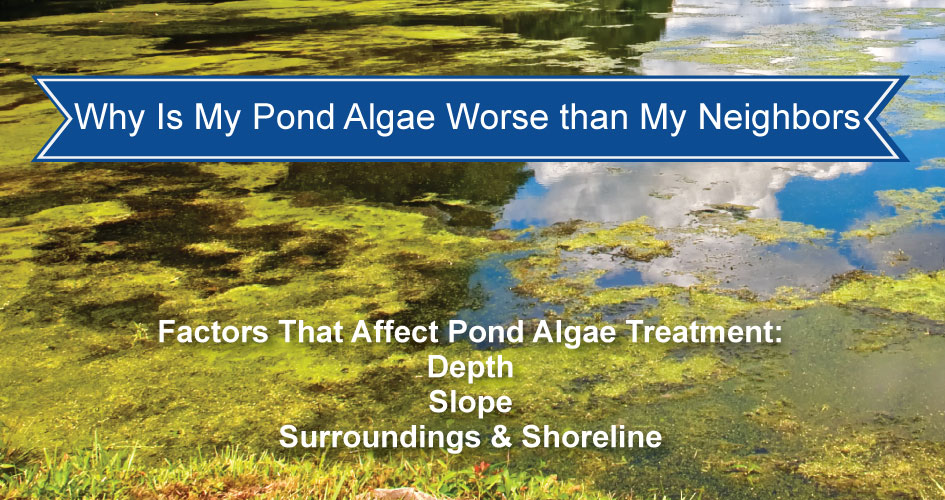It is human nature to compare. We compare our homes, cars, kids… so why wouldn’t you compare your pond to your neighbors? “My neighbors pond is beautiful and mine is covered in pond algae…WHY?” No two ponds are the same and to expect the same conditions in two different ponds is absurd. Pond algae treatment will look different for every pond!
No two ponds are the same, even if they are dug right next to each other. Let’s compare two hypothetical ponds. You and your neighbors pond are roughly the same surface acres and only about ¼ mile apart from each other. You have the same species of fish, you both use pond dye, pond bacteria, and about the same amount of pond algaecide for your pond algae treatments. However, your pond is covered in algae. Upon closer inspection, you find your pond is on average 4 feet deep and your neighbors average depth is 7 feet. This one difference can make a big difference. In shallow ponds, the water gets warmer quicker and the sunlight can reach the pond floor, which entices growth at a much more rapid rate than in deeper ponds. Pond owners with shallow ponds will have to fight twice as hard to maintain pond algae than a pond that is deeper.
There are many ways that your pond can differ compared to your neighbor’s pond. We are going to go over some characteristics that can make a big difference in the health of your pond.

Depth
Generally, the deeper the pond and the steeper the grade, the better. The deeper the water in the pond, the less sunlight will reach the bottom of the pond. If pond algae can’t get enough sunlight, the growth will dramatically slow down. Generally, once a pond is around 8 to 10 feet deep, the algae will not flourish and, if pond dye is added, pond algae is slowed even more. Of course, some people love beach areas. Just make sure to treat these areas as they are likely to grow weeds and algae. Remember, the deeper the pond, the less algae problems you will have.
Slope
After considering depth, you will need to address the steepness of the pond’s slope. Generally, the faster the drop off, the better the algae control will be. When constructing ponds, many local government stipulations require a “safety shelf” to be added to the perimeter of the pond. This allows people and animals a way to quickly exit the pond without undue struggles. However, this shelf is a great place for algae to grow. What’s the answer? Check your local laws and follow them. If they require the safety shelf, try to keep the shelf narrow and increase the slope quickly after you are past the shelf. The shoreline above water does not benefit from a steep slope, so this involves only the underwater portion of the slope. Remember, the steeper the underwater slope, the less opportunity for algae to thrive!
Surroundings & Shoreline
Another major consideration is what is surrounding the pond. Do you have farmland around you? Do you fertilize your yard? These are important questions because the same products that are applied to fields and lawns to make them green will make your pond green. Ponds are holes in the ground and will collect runoff from surrounding areas. Keep a 15ft. band around your pond that you do not fertilize. This band will give a buffer/filter when it rains. Shoreline construction and maintenance is an important part of filtering runoff too. Keep grass around the pond several inches higher and rock borders will help with erosion and filtration which all leads to more successful pond algae treatments.
These characteristics can drastically affect your pond algae treatment regimen. If anyone of these are slightly different than your neighbors pond it will make your pond algae treatment completely different.
If you are struggling with your pond algae treatment, contact us.
Next Monday we will release Part 5 of our Pond Algae Treatment Series: Tips to Slow Down Pond Algae Growth
Part 1: Different Algae Require Different Pond Algae Treatment
Part 2: When Do I Start Pond Algae Treatment?
Part 3: Will Pond Algae Treatment Hurt My Fish?
Part 4: Why Is My Pond Algae Worse Than My Neighbors? (Current Blog Post)

